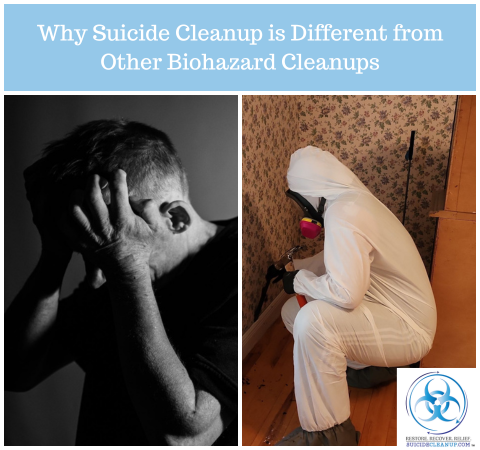
What To Do If Your Tenant Dies By Suicide: Guide for Landlords
March 28, 2025When people think of biohazard cleanup, they often imagine a standardized process involving blood, bodily fluids, and protective gear. But not all biohazard scenes are the same. Suicide scene cleanup stands apart in both its emotional gravity and technical complexity. Unlike other trauma or crime scenes, cleaning after a suicide requires a specialized approach — one that balances professional decontamination with deep compassion for those left behind.
What Qualifies as a Suicide Scene Cleanup?
Suicide scene cleanup refers to the professional removal of biological hazards following a self-inflicted death. These scenes vary widely, depending on the method of suicide. Common scenarios include:
Gunshot wounds, often leaving significant blood and tissue damage
Overdoses, which may result in bodily fluid release and prolonged decomposition
Hangings, which may include blood, waste, and odor
Self-harm with sharp objects, often confined to specific areas but still requiring thorough remediation
Each of these situations results in a unique contamination profile. Biohazard suicide cleaning typically involves more than just wiping down surfaces. Blood, brain matter, and other biological materials can seep into flooring, walls, and furniture, demanding expert-level sanitation to eliminate health risks and lingering odors.
Key Differences from Other Biohazard Scenes
While biohazard cleanup always requires strict safety protocols, suicide scenes add layers of complexity:
Emotional Sensitivity
In many suicide scene cleanup cases, family members or friends are still present in the home. These individuals are navigating an unimaginable emotional crisis. Unlike some crime scenes, there may be no criminal investigation or police barrier — just a grieving household and a space in desperate need of respectful restoration.
Scene Complexity
Suicides are often discovered after hours or even days, especially in cases of overdose or hanging. This delay can lead to advanced decomposition, which poses additional health and sanitation challenges. Strong odors, insect activity, and structural damage can all complicate the cleanup process.
Mental Health Considerations
The trauma of discovering a loved one’s suicide can leave lasting emotional scars. Inappropriate or careless handling of the cleanup can worsen that trauma. Professional cleanup teams must recognize the risks of PTSD and emotional distress in those affected. Providing discreet, respectful service is as vital as the technical work itself.
The Emotional Toll on Families
Cleaning after suicide is not just a physical task — it’s an emotional burden that no family should carry alone. The scene often becomes a painful, permanent memory for those involved. Seeing blood, personal items, or evidence of the act can amplify grief, shock, and guilt.
This is why professional suicide cleanup services must go beyond sterilization. They must prioritize empathy, discretion, and grief-informed care. Teams trained in trauma response understand how to navigate these deeply personal situations without adding further emotional harm.
Technical Aspects of Suicide Scene Cleanup
Dealing with biological contaminants from a suicide scene requires more than household cleaning products or basic sanitation procedures. Suicide cleanup professionals use:
Advanced decontamination methods such as EPA-approved disinfectants and ATP testing to ensure thorough cleaning
Odor removal strategies including ozone treatment and hydroxyl generators, which are especially important in cases involving decomposition
Protective protocols to avoid cross-contamination, especially when working in occupied homes where grieving family members may still be present
Every element of the cleanup — from personal protective equipment (PPE) to waste disposal — is regulated and performed with clinical precision.
Legal and Ethical Considerations
Who is responsible for suicide cleanup? In most cases, it falls to the property owner or next of kin. Many homeowners’ insurance policies offer some level of biohazard cleanup coverage, but this varies widely. It’s essential for families to check their specific policy and work with a cleanup team that can help navigate these details.
Ethically, suicide cleanup professionals must maintain strict confidentiality, treat the deceased with respect, and handle personal belongings with care. The goal is not only to restore the space physically but to preserve the dignity of everyone involved.
Choosing the Right Cleanup Team
Not every cleaning company is equipped — emotionally or technically — to handle suicide cleanup. When searching for help, families should look for:
Trauma-trained professionals with experience in suicide and biohazard response
Companies that meet all OSHA, EPA, and local health regulations
Discreet service with unmarked vehicles, if desired
A reputation for compassion, discretion, and professionalism — testimonials and certifications can be useful indicators
A reputable team will understand the nuance between trauma cleanup vs suicide cleanup and know that this isn’t just another job — it’s a critical step in someone’s grieving and healing process.
Conclusion
Suicide cleanup is unlike any other type of biohazard work. It demands not only technical skill but also emotional intelligence and ethical responsibility. From cleaning up hazardous materials to supporting mental health considerations, the job is complex — and deeply human.
If you or someone you love is facing the aftermath of a suicide, don’t go through it alone. SuicideCleanup.com is here to help 24/7 with compassionate, professional, and respectful service. We understand the emotional trauma of suicide cleanup and are committed to making this painful process a little less overwhelming.



